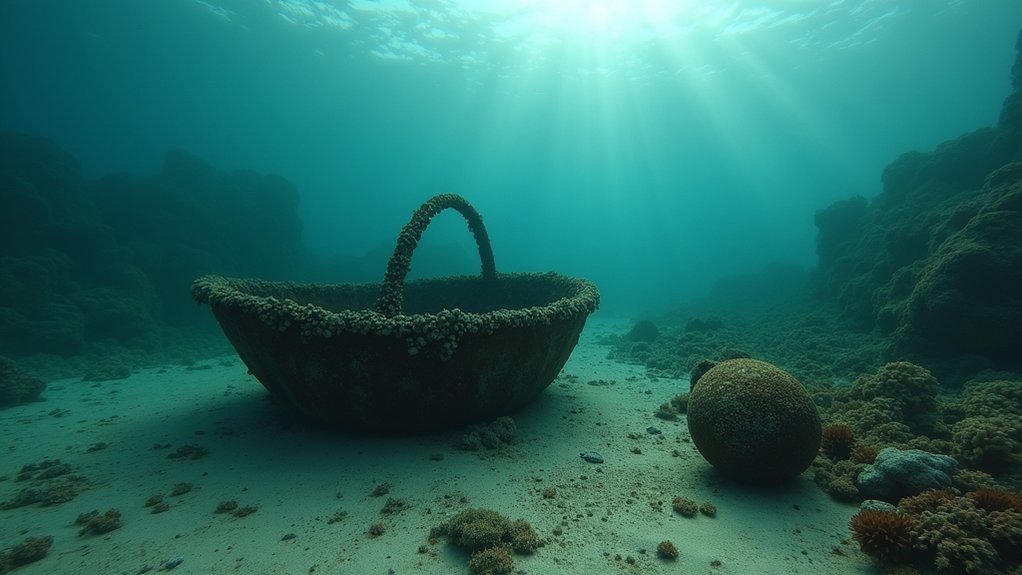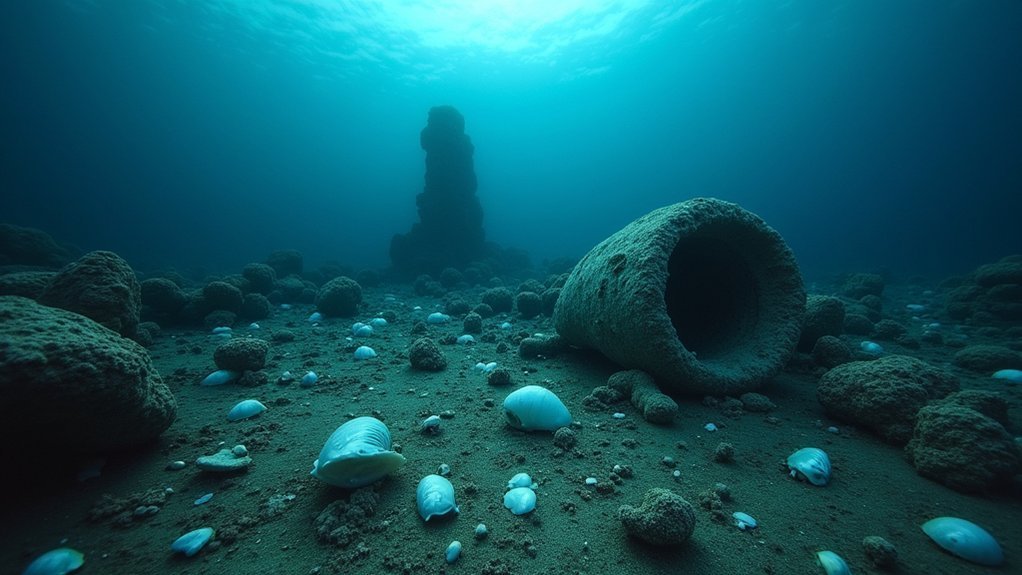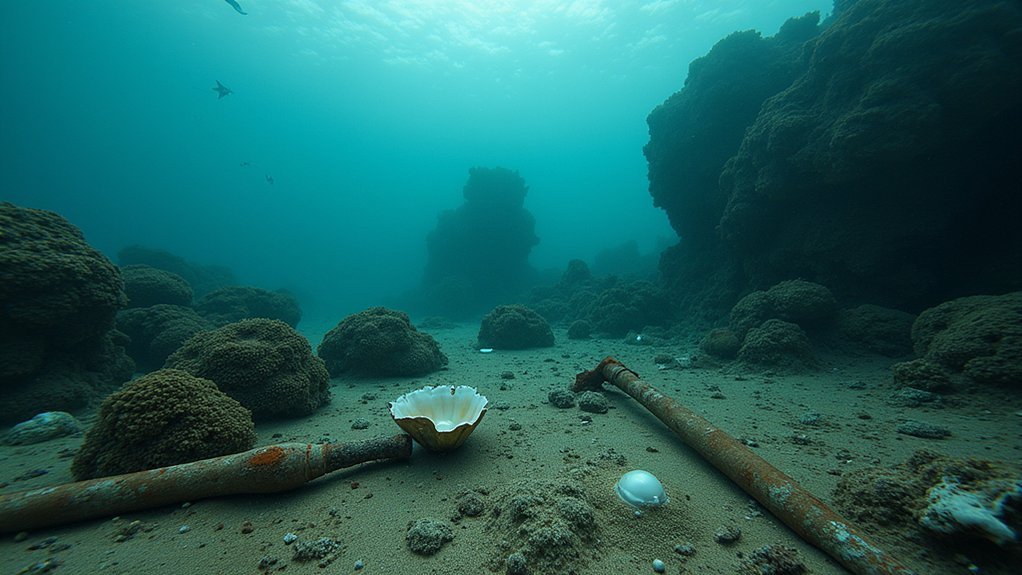Traditional pearl harvesting was extremely dangerous with mortality rates reaching 50%. You’d face risks like drowning while diving 30 meters without breathing apparatus, shallow water blackout, and attacks from marine predators like sharks. Divers suffered from decompression sickness, oxygen deprivation, and exploitation through minimal pay and demanding quotas. The combination of crude equipment, environmental hazards, and economic pressures made this one of history’s deadliest professions. Discover how these brave divers risked everything for these precious gems.
The Perils of Traditional Pearl Diving

Five major dangers haunted traditional pearl divers as they plunged into the ocean’s depths.
You’d be shocked to learn that mortality rates reached a staggering 50% in this profession. Descending up to 30 meters without breathing apparatus, divers risked drowning while harvesting pearl oysters. They played an important role in the industry, but at devastating personal cost.
Shallow water blackout was a constant threat as divers pushed their breath-holding limits.
When ascending quickly, they often suffered from “the bends” or decompression sickness, causing excruciating pain and sometimes death. Underwater hazards completed this deadly state of affairs.
This dangerous approach to pearl farming eventually raised ethical concerns, contributing to the decline of traditional diving communities as the physical toll became impossible to ignore.
Hazardous Breathing Techniques and Equipment
Traditional pearl divers employed dangerously primitive breathing methods that made their profession extraordinarily lethal. You’d be shocked to learn that these divers relied solely on holding their breath while descending to extreme depths, with mortality rates reaching a staggering 50%.
Their diving gear often included crude weights to help them sink faster, but these same weights increased physical strain and accident risk. Without protective equipment, divers faced direct exposure to sharp shells and marine predators.
The most hazardous aspect of pearl harvesting remained the constant threat of oxygen deprivation. Extended dives frequently led to unconsciousness underwater, with fatal consequences. Without modern breathing apparatus, divers pushed their bodies to dangerous limits, risking decompression sickness and drowning with each descent into the depths.
Marine Predators and Environmental Threats

Beyond the dangers of oxygen deprivation, pearl divers faced a gauntlet of natural predators that turned each harvest into a potentially fatal encounter.
When you dove for pearls, you’d navigate waters where sharks and barracudas actively hunted, with limited visibility often preventing you from spotting these marine predators until they were dangerously close.
The environmental threats compounded these risks:
- Strong unpredictable currents could sweep you away from safety or slam you against coral reefs.
- Toxic red tides contaminated waters and decimated oyster populations.
- Rising pollution levels contributed to reef degradation while exposing you to harmful chemicals.
With historical mortality rates reaching a staggering 50%, your odds of surviving a career in pearl harvesting were effectively equivalent to a coin toss—a stark reminder of the profession’s extreme dangers.
Physical Toll and Health Consequences
Despite advances in harvesting techniques, the brutal physical impact of pearl diving remains etched in the industry’s legacy. You’d be shocked to learn that historically, pearl diving carried a staggering 50% mortality rate, making it one of the world’s deadliest professions.
Before modern diving technology emerged, divers routinely suffered from decompression sickness—”the bends”—when ascending too rapidly from depths. The harsh underwater conditions, including strong currents and limited visibility, only amplified these dangers.
Divers endured extended periods submerged, leading to exhaustion, hypothermia, and chronic health issues that permanently damaged their bodies. Early pearl farming lacked today’s safety protocols, leaving divers vulnerable to these severe physical consequences.
The toll on human life and wellbeing was an overlooked cost behind the lustrous pearls adorning jewelry throughout history.
Economic Pressures and Exploitation of Divers

While the physical dangers of pearl diving were severe, the economic realities created equally troubling conditions of exploitation. The pearl industry thrived on the backs of divers who faced overwhelming economic pressures to produce, often at the expense of their wellbeing.
You’d have encountered these exploitative practices in three key ways:
- Minimal compensation that forced you to take extreme risks for financial survival.
- Demanding quotas that required you to dive repeatedly without adequate rest.
- Absence of basic safety measures as profits were prioritized over your protection.
Diving operations rarely invested in proper equipment or training, instead treating divers as expendable resources.
The staggering 50% mortality rate reveals the brutal calculus at work—your life was considered less valuable than the pearls you harvested.
Frequently Asked Questions
Is Pearl Harvesting Harmful?
Pearl harvesting is harmful. You’ll find it endangers divers with high mortality rates, depletes bivalve populations, causes animal suffering, increases oyster deaths through mass production, and spreads diseases in farming operations.
Does Harvesting Pearls Hurt the Clam?
Pearl harvesting can hurt clams. When you pry open a clam’s shell, it might damage or kill the animal. While they lack brains, clams do show defensive reactions suggesting they’re trying to avoid harm.
Is It Painful to Remove a Pearl From an Oyster?
While oysters don’t have brains to process pain as we do, they show stress responses when you pry open their shells. You’re likely causing distress to the oyster when you remove a pearl.
Is Pearl Farming Bad for the Environment?
Pearl farming can harm the environment if managed poorly. You’ll find pollution from nutrient runoff, habitat disruption of coral reefs, and ecosystem changes from overcrowding. However, sustainable practices like IMTA can minimize these negative impacts.
In Summary
When you look back at pearl harvesting’s dangerous past, you’re seeing a deadly combination of primitive diving equipment, marine threats, and physical peril. You can’t ignore how divers suffered from decompression sickness, oxygen deprivation, and shark encounters. They’ve endured exploitation through debt bondage and harsh quotas. Today’s cultured pearl methods are safer, but you’re witnessing the legacy of an industry built on tremendous human sacrifice.





Leave a Reply